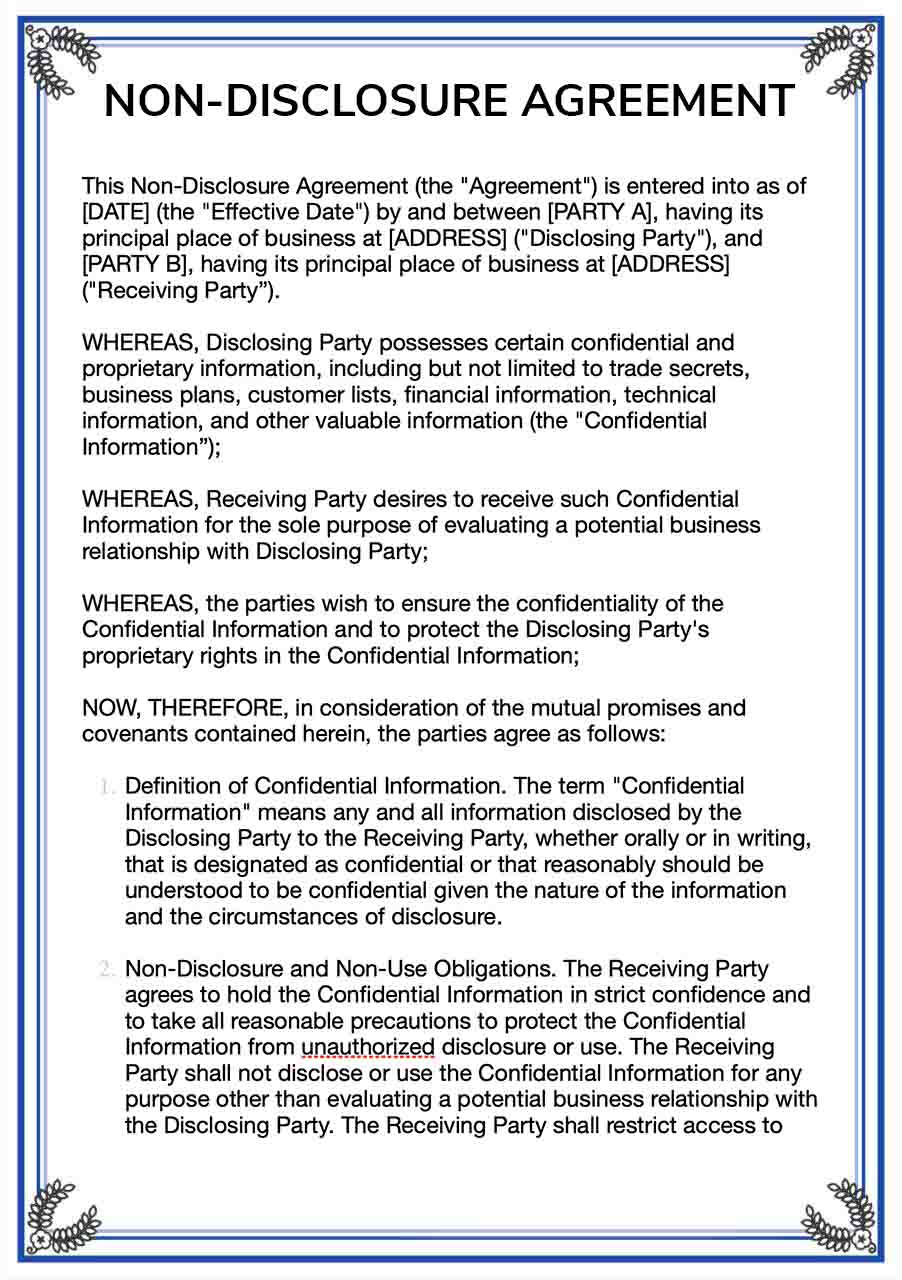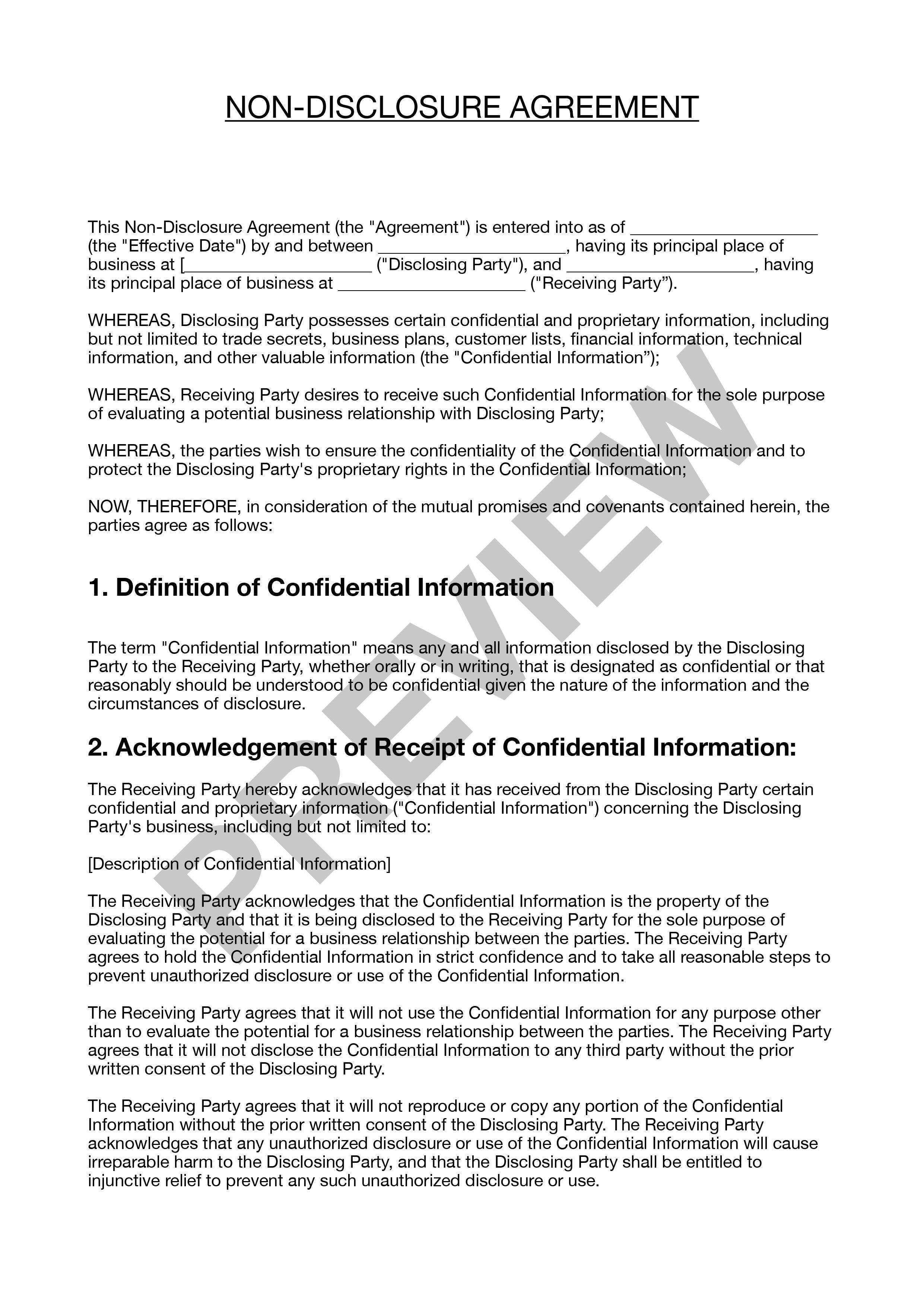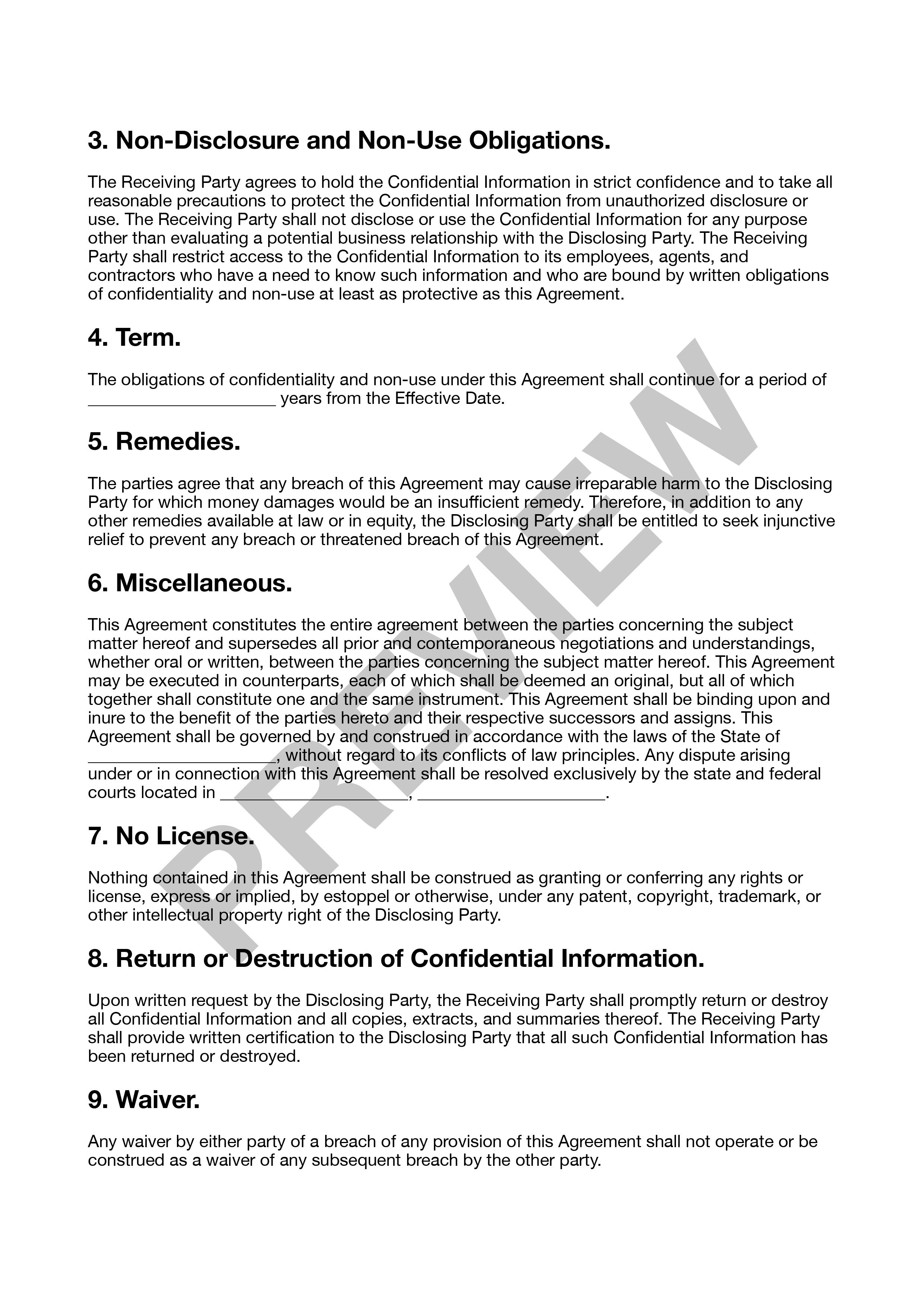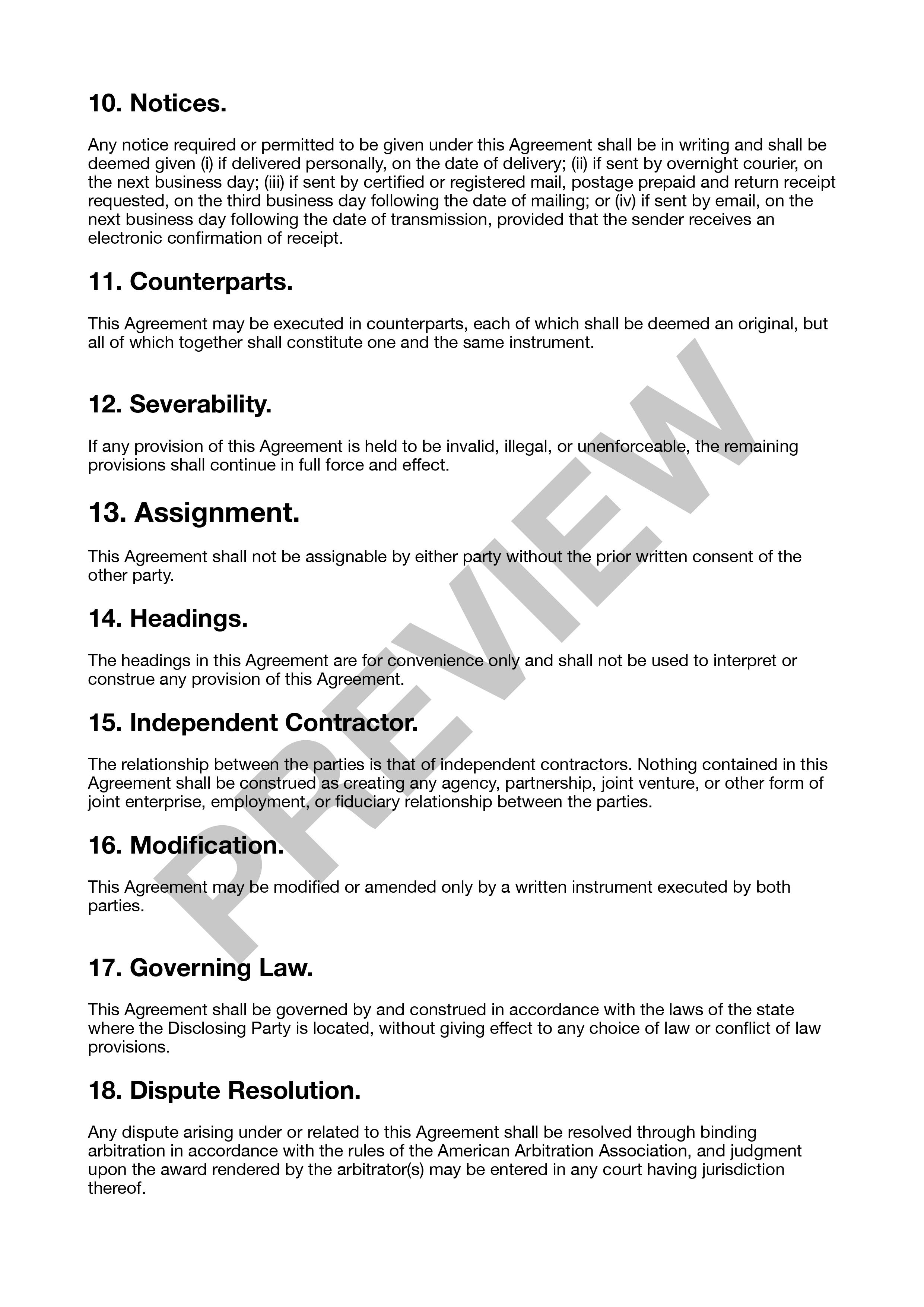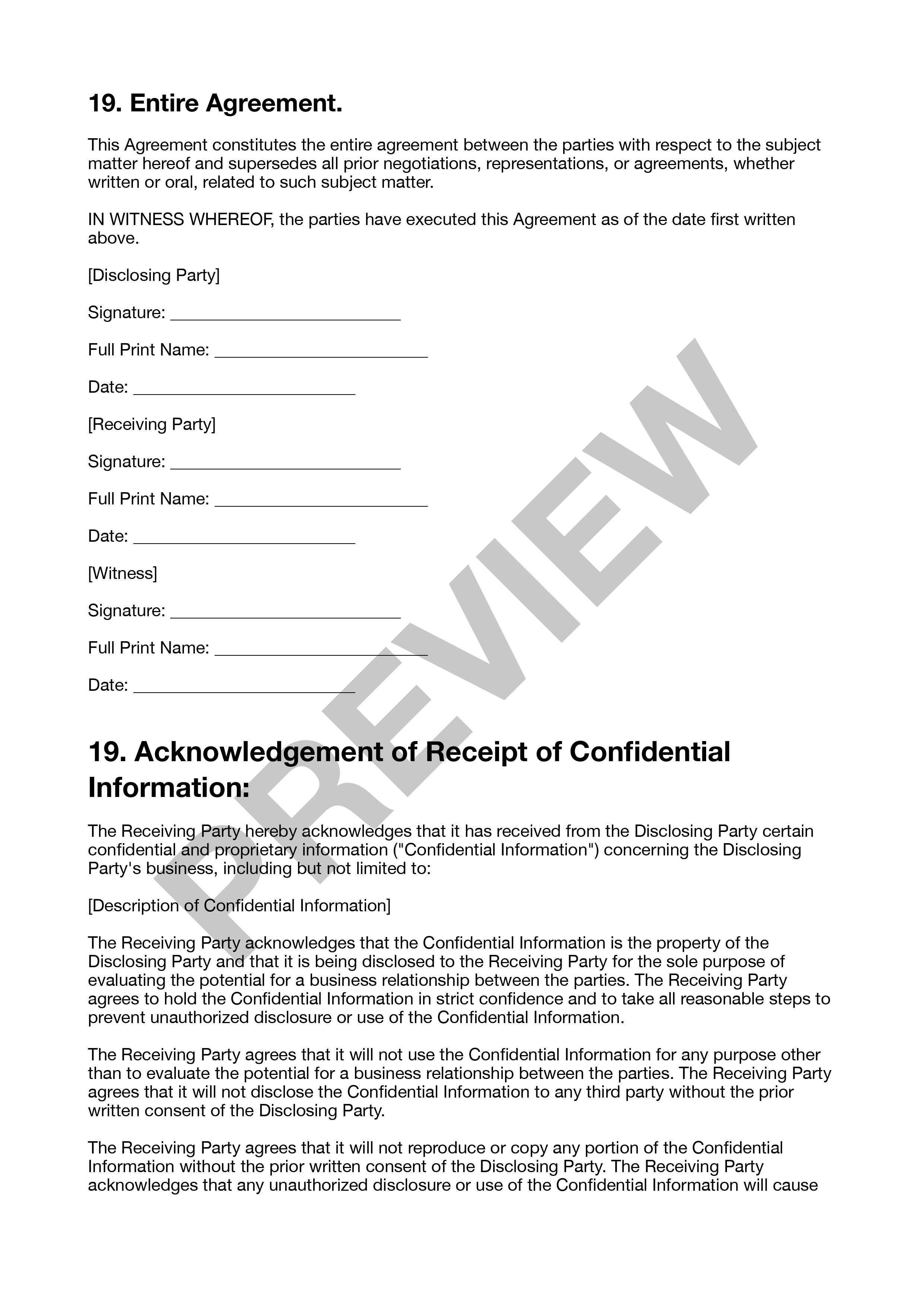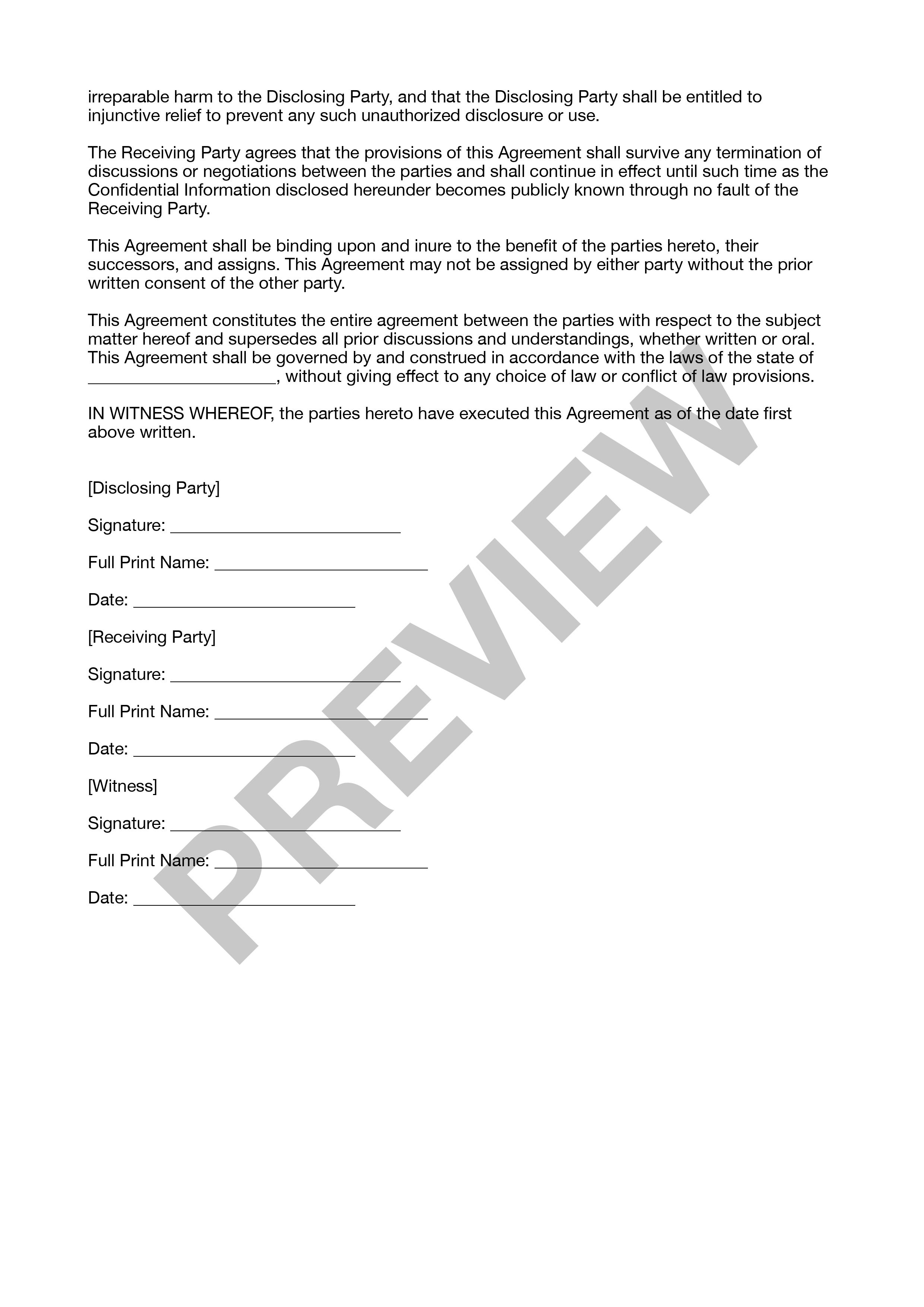Last Updated April 2023
Alternative names:
Confidentiality agreement Secrecy agreement NDA contract Confidential disclosure agreementWhat is a Non-Disclosure Agreement?
A Non-Disclosure Agreement (NDA) is a legal contract between two or more parties that prohibits the disclosure of confidential or proprietary information shared between them. NDAs are often used to protect sensitive business information, trade secrets, or other valuable intellectual property.
The terms of an NDA typically specify what information is considered confidential, how it should be used by the recipient, and the duration of the agreement. Violating an NDA can result in legal consequences such as monetary damages or injunctions to prevent further disclosure.
NDAs can be mutual, meaning both parties agree to keep each other's information confidential, or one-sided, where only one party is required to keep the information confidential. NDAs are commonly used in a variety of industries such as technology, healthcare, and finance.
Types of Non-Disclosure Agreements (NDAs)
There are two main types of Non-Disclosure Agreements (NDAs):
-
Unilateral NDA: This type of NDA is used when only one party is sharing confidential information with another party. The recipient of the information agrees not to disclose it to anyone else.
-
Mutual NDA: This type of NDA is used when both parties will be sharing confidential information with each other. Both parties agree to keep each other's information confidential.
There are also different categories of NDAs that may be used for specific situations or industries, such as:
-
Employee NDA: Used to protect confidential information that employees may have access to during their employment.
-
Vendor NDA: Used to protect confidential information that vendors or suppliers may have access to while working with a company.
-
Investor NDA: Used to protect confidential information that may be shared with potential investors during fundraising efforts.
-
Technology NDA: Used to protect confidential information related to technology products, processes, or systems.
-
Business sale NDA: Used to protect confidential information related to the sale or acquisition of a business.
-
Creative work NDA: Used to protect confidential information related to creative works such as films, music, or art.
-
Real estate NDA: Used to protect confidential information related to the sale or lease of real estate.
The specific type of NDA used will depend on the nature of the confidential information being shared and the circumstances under which it is being shared.
How do I create an NDA?
To create an NDA, follow these general steps:
-
Determine the parties involved: Identify the parties who will be sharing and receiving the confidential information.
-
Define the confidential information: Clearly describe the confidential information that will be shared between the parties and what type of information is covered by the NDA.
-
Set the duration of the NDA: Determine the length of time the NDA will remain in effect.
-
Specify the exclusions: List any information that is not covered by the NDA, such as information that is already publicly available.
-
Describe the obligations: Clearly state the obligations of the parties with respect to the confidential information, such as how it should be used, protected, and returned or destroyed at the end of the NDA term.
-
Add any additional provisions: Depending on the situation, additional provisions may be needed, such as governing law, jurisdiction, or remedies for breach.
-
Get it reviewed and signed: Once the NDA is drafted, have it reviewed by an attorney, and signed by all parties involved.
What information should be included in an NDA?
An NDA should include the following information:
- The names and contact information of the parties involved.
- A clear definition of what information is considered confidential.
- The duration of the NDA, specifying how long the information must be kept confidential.
- Any exclusions or exceptions to what is considered confidential.
- The obligations of the receiving party, such as how they are required to protect the confidential information and how it can be used.
- The consequences for breach of the NDA, including any legal or financial penalties.
- A statement acknowledging that the disclosing party retains ownership of the confidential information.
- Governing law and jurisdiction in case of a legal dispute.
- Signatures of both parties and the date signed.
It's important to note that the specific details to be included in an NDA may vary depending on the nature of the confidential information and the circumstances under which it is being shared. It is recommended to seek legal advice when drafting an NDA to ensure it is legally sound and provides adequate protection.
Frequently Asked Questions
The purpose of a Non-Disclosure Agreement (NDA) is to protect confidential or proprietary information that is shared between parties. NDAs are legal contracts that define the terms and conditions for sharing and handling this information. The main goal of an NDA is to safeguard sensitive information and prevent it from being used for unauthorized purposes, which can include copying, distributing, or sharing the information with third parties. NDAs are commonly used in business to protect trade secrets, confidential information, and other proprietary information. By having an NDA in place, businesses can help ensure the protection of their valuable information and reduce the risk of unauthorized disclosure or theft.
Yes, an NDA can be modified or cancelled if both parties involved agree to the changes. Any modification or cancellation should be documented in writing and signed by both parties to ensure that it is legally binding. It's important to note that modifying or cancelling an NDA can have legal consequences, so it is recommended to consult with a lawyer before making any changes to the agreement. Additionally, any confidential information shared under the original NDA may still be subject to the terms of the agreement, even if it has been modified or cancelled.
Anyone who shares or receives confidential information needs a Non-Disclosure Agreement (NDA) to protect the sensitive information. NDAs are particularly important in business contexts where companies need to share proprietary or confidential information with employees, contractors, vendors, investors, or other parties. Some common situations where an NDA may be necessary include:
-
Business partnerships or collaborations that involve sharing sensitive information.
-
Hiring employees or contractors who will have access to confidential information.
-
Seeking investment or funding for a business idea or product.
-
Working with third-party vendors or suppliers who may have access to confidential information.
-
Negotiating a potential merger or acquisition.
In general, any time sensitive information is being shared between parties and confidentiality is critical, an NDA is necessary. It's always better to be safe than sorry when it comes to protecting sensitive information, so having an NDA in place can provide peace of mind and legal protection for all parties involved.
If someone breaches a Non-Disclosure Agreement (NDA), the consequences can be significant. The specific consequences will depend on the terms outlined in the NDA and the severity of the breach. Some potential consequences for breaching an NDA include:
-
Legal action: The party who was harmed by the breach can take legal action against the other party to seek damages or an injunction to prevent further disclosure of confidential information.
-
Financial damages: The breaching party may be required to pay financial damages to the other party for any harm caused by the breach.
-
Loss of business or reputation: Breaching an NDA can lead to a loss of trust and damage to one's reputation, which can impact future business opportunities.
It's important to take NDA breaches seriously and to act quickly if a breach occurs. The first step is to review the terms of the NDA and assess the damage caused by the breach. If necessary, legal action should be taken to protect the confidential information and seek damages for any harm caused.
There is no significant difference between a Non-Disclosure Agreement (NDA) and a Confidentiality Agreement. Both agreements are legal contracts that define the terms and conditions for sharing and handling confidential information. NDAs are generally used in business contexts, while confidentiality agreements can be used in a wider variety of settings.
The main purpose of both agreements is to protect confidential or proprietary information from being disclosed to unauthorized parties. They outline the types of information that are considered confidential, how the information can be used, and the consequences for breaching the agreement. The terms of both agreements can be customized to fit the specific needs of the parties involved.
In summary, the terms "Non-Disclosure Agreement" and "Confidentiality Agreement" are often used interchangeably and refer to the same type of legal document used to protect confidential information.
